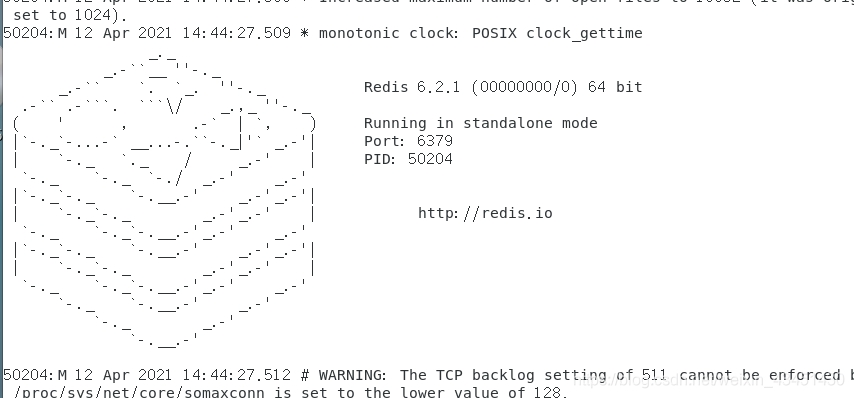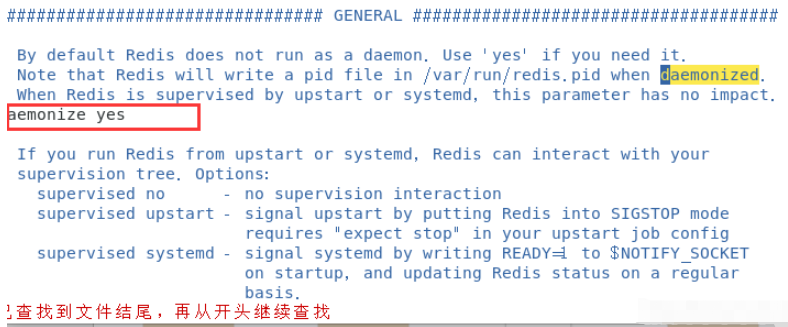//安装c++yum install gcc-c++ -y//查看版本gcc -v
cd redis-6.2.1make
make install
make install PREFIX=/usr/local/redis//后面的是你想要安装的路径
cd /cd usr/local/bin./redis-server
./redis-server redis.conf
ps aux|grep redis
How to install and configure Redis in Centos7
Centos7 install Redis
0, update the file
yum update -y
1, download redis

cd export/install
tar -zxvf redis-6.2.1.tar.gz
Copy after login
3. Installation environment c cd export/install tar -zxvf redis-6.2.1.tar.gz
//安装c++yum install gcc-c++ -y//查看版本gcc -v
Copy after login
//安装c++yum install gcc-c++ -y//查看版本gcc -v

cd redis-6.2.1make
Copy after login
5. Installation serviceThis is the default installationcd redis-6.2.1make
make install
Copy after login
This is a custom installationmake install
make install PREFIX=/usr/local/redis//后面的是你想要安装的路径
Copy after login
I am the default installation. make install PREFIX=/usr/local/redis//后面的是你想要安装的路径

cd /cd usr/local/bin./redis-server
Copy after login
The startup is successful as shown below. cd /cd usr/local/bin./redis-server

cd /cd export/install/redis-6.2.1cp redis.conf /usr/local/bin/
cd /cd usr/local/bin
vim redis.conf
Copy after login
Here is the modification to run in the background. After opening the file,If you want to search, directly enter / in the field you want to search for such as /daemonized and press Enter to search,Press n to indicate the next match The characters :cd /cd usr/local/bin vim redis.conf

./redis-server redis.conf
Copy after login
7.3. Check whether the process is started./redis-server redis.conf
ps aux|grep redis
Copy after login
ps aux|grep redis
 ##8. Close the service
##8. Close the service
./redis-cli shutdown
9. Simply use redis
to open the redis service.:
Open the redis client.
#Test:It is correct that pong appears.
 Exit
Exit
./redis-server redis.conf ./redis-cli
10. Start remote connection Firewall allows.
Firewall allows.
quit
Modify the redis.conf configuration file
Turn off the protected-mode mode,At this time, the external network can directly access
firewall-cmd --zone=public --add-port=6379/tcp --permanent firewall-cmd --reload
This is the format display for setting the password.
Remember to restart the service after modifying it.
修改redis.conf 文件,protected-mode 要设置成no。//如果需要设置密码requirepass 空格后面跟设置的密码修改redis.conf 文件,将 bind 127.0.0.1 修改成bind * -::* 或者直接将bind这一行注释掉
Link redis with other ip addresses The ip here is changed according to the ip address you want to link to
The ip here is changed according to the ip address you want to link to
redis-cli -h 127.0.0.1 -p 6379 shutdown # 干掉redis服务器(比较暴力,谨慎使用) sudo kill -9 pid 进程号
Remote link with password
./redis-cli -h 192.168.10.20 -p 6379
The above is the detailed content of How to install and configure Redis in Centos7. For more information, please follow other related articles on the PHP Chinese website!

Hot AI Tools

Undresser.AI Undress
AI-powered app for creating realistic nude photos

AI Clothes Remover
Online AI tool for removing clothes from photos.

Undress AI Tool
Undress images for free

Clothoff.io
AI clothes remover

Video Face Swap
Swap faces in any video effortlessly with our completely free AI face swap tool!

Hot Article

Hot Tools

Notepad++7.3.1
Easy-to-use and free code editor

SublimeText3 Chinese version
Chinese version, very easy to use

Zend Studio 13.0.1
Powerful PHP integrated development environment

Dreamweaver CS6
Visual web development tools

SublimeText3 Mac version
God-level code editing software (SublimeText3)

Hot Topics
 How to optimize CentOS HDFS configuration
Apr 14, 2025 pm 07:15 PM
How to optimize CentOS HDFS configuration
Apr 14, 2025 pm 07:15 PM
Improve HDFS performance on CentOS: A comprehensive optimization guide to optimize HDFS (Hadoop distributed file system) on CentOS requires comprehensive consideration of hardware, system configuration and network settings. This article provides a series of optimization strategies to help you improve HDFS performance. 1. Hardware upgrade and selection resource expansion: Increase the CPU, memory and storage capacity of the server as much as possible. High-performance hardware: adopts high-performance network cards and switches to improve network throughput. 2. System configuration fine-tuning kernel parameter adjustment: Modify /etc/sysctl.conf file to optimize kernel parameters such as TCP connection number, file handle number and memory management. For example, adjust TCP connection status and buffer size
 Centos shutdown command line
Apr 14, 2025 pm 09:12 PM
Centos shutdown command line
Apr 14, 2025 pm 09:12 PM
The CentOS shutdown command is shutdown, and the syntax is shutdown [Options] Time [Information]. Options include: -h Stop the system immediately; -P Turn off the power after shutdown; -r restart; -t Waiting time. Times can be specified as immediate (now), minutes ( minutes), or a specific time (hh:mm). Added information can be displayed in system messages.
 How to install mysql in centos7
Apr 14, 2025 pm 08:30 PM
How to install mysql in centos7
Apr 14, 2025 pm 08:30 PM
The key to installing MySQL elegantly is to add the official MySQL repository. The specific steps are as follows: Download the MySQL official GPG key to prevent phishing attacks. Add MySQL repository file: rpm -Uvh https://dev.mysql.com/get/mysql80-community-release-el7-3.noarch.rpm Update yum repository cache: yum update installation MySQL: yum install mysql-server startup MySQL service: systemctl start mysqld set up booting
 Centos stops maintenance 2024
Apr 14, 2025 pm 08:39 PM
Centos stops maintenance 2024
Apr 14, 2025 pm 08:39 PM
CentOS will be shut down in 2024 because its upstream distribution, RHEL 8, has been shut down. This shutdown will affect the CentOS 8 system, preventing it from continuing to receive updates. Users should plan for migration, and recommended options include CentOS Stream, AlmaLinux, and Rocky Linux to keep the system safe and stable.
 How to check CentOS HDFS configuration
Apr 14, 2025 pm 07:21 PM
How to check CentOS HDFS configuration
Apr 14, 2025 pm 07:21 PM
Complete Guide to Checking HDFS Configuration in CentOS Systems This article will guide you how to effectively check the configuration and running status of HDFS on CentOS systems. The following steps will help you fully understand the setup and operation of HDFS. Verify Hadoop environment variable: First, make sure the Hadoop environment variable is set correctly. In the terminal, execute the following command to verify that Hadoop is installed and configured correctly: hadoopversion Check HDFS configuration file: The core configuration file of HDFS is located in the /etc/hadoop/conf/ directory, where core-site.xml and hdfs-site.xml are crucial. use
 What steps are required to configure CentOS in HDFS
Apr 14, 2025 pm 06:42 PM
What steps are required to configure CentOS in HDFS
Apr 14, 2025 pm 06:42 PM
Building a Hadoop Distributed File System (HDFS) on a CentOS system requires multiple steps. This article provides a brief configuration guide. 1. Prepare to install JDK in the early stage: Install JavaDevelopmentKit (JDK) on all nodes, and the version must be compatible with Hadoop. The installation package can be downloaded from the Oracle official website. Environment variable configuration: Edit /etc/profile file, set Java and Hadoop environment variables, so that the system can find the installation path of JDK and Hadoop. 2. Security configuration: SSH password-free login to generate SSH key: Use the ssh-keygen command on each node
 What are the common misunderstandings in CentOS HDFS configuration?
Apr 14, 2025 pm 07:12 PM
What are the common misunderstandings in CentOS HDFS configuration?
Apr 14, 2025 pm 07:12 PM
Common problems and solutions for Hadoop Distributed File System (HDFS) configuration under CentOS When building a HadoopHDFS cluster on CentOS, some common misconfigurations may lead to performance degradation, data loss and even the cluster cannot start. This article summarizes these common problems and their solutions to help you avoid these pitfalls and ensure the stability and efficient operation of your HDFS cluster. Rack-aware configuration error: Problem: Rack-aware information is not configured correctly, resulting in uneven distribution of data block replicas and increasing network load. Solution: Double check the rack-aware configuration in the hdfs-site.xml file and use hdfsdfsadmin-printTopo
 Centos configuration IP address
Apr 14, 2025 pm 09:06 PM
Centos configuration IP address
Apr 14, 2025 pm 09:06 PM
Steps to configure IP address in CentOS: View the current network configuration: ip addr Edit the network configuration file: sudo vi /etc/sysconfig/network-scripts/ifcfg-eth0 Change IP address: Edit IPADDR= Line changes the subnet mask and gateway (optional): Edit NETMASK= and GATEWAY= Lines Restart the network service: sudo systemctl restart network verification IP address: ip addr






